Fact check: Did Gov Christie really eliminate an $11 billion budget gap in 2010?

New Jersey Gov. Chris Christie signs the state's budget into law Tuesday June 29, 2010. (AP Photo/Mel Evans)
Gov. Chris Christie’s claim that he closed an $11 billion budget deficit in New Jersey shortly after taking office in 2010 has become a key feature of his presidential-campaign message as he stumps for votes in states like Iowa and New Hampshire.
But new budget estimates obtained by NJ Spotlight show a far more modest result when the makeup of the budget Christie inherited roughly five years ago is compared to the spending plan he just signed into law about a month ago.
The NJ Spotlight analysis of the new figures shows Christie, in real dollars, has been able to whittle about $500,000 off the state’s structural budget gap during his tenure, taking it from $10.7 billion in 2010 down to $10.23 billion this summer.
That’s a nice accomplishment given New Jersey’s longstanding fiscal challenges, but one far less impressive than the $11 billion claim he’s been making as a 2016 GOP primary candidate with a “Tell It Like It Is” campaign slogan.
The explanation for the difference between the big number Christie has been talking about and what’s actually occurred with New Jersey’s budget over the past five years is rooted in the routine calculation by legislative analysts of what’s known as the “structural deficit,” an often misunderstood figure that is regularly abused for political purposes.
In practice, the structural deficit is a useful tool for policymakers. It assesses the difference between projected state revenues using all current taxes and the projected spending that all current programs call for, whether that’s simply flat funding or covering planned increases.
With those estimates in mind, governors and lawmakers have to decide each year whether to raise taxes or underfund programs to keep spending in line with revenues — something that’s required by a state constitution that forbids real deficits. The exercise typically produces a wide structural gap due to chronic underfunding.
When Christie took office in early 2010, he inherited a $10.7 billion structural deficit heading into the 2011 fiscal year, a figure he now rounds up to $11 billion in stump speeches.
To address that structural gap, Christie didn’t cut $11 billion in spending in real dollars. Doing that would have equaled 37 percent of total spending since the state budget was about $29 billion at the time.
Instead, to “close” the structural deficit Christie, like many governors have before him, simply didn’t fully fund a host of programs. They included Homestead property tax-relief rebates and the state’s school-aid law.
Other budget items were altogether ignored, like the $3 billion state contribution into the public-employee pension system that was called for by actuaries that year. And he didn’t raise any taxes to bring in more revenue, something Democrats who control the Legislature called for.
Now, with a new $33.8 billion budget just signed into law by Christie at the end of June, legislative analysts have conducted their latest calculation of the structural deficit. That estimate, a copy of which was obtained by NJ Spotlight, shows a $10.23 billion structural deficit heading into the next fiscal year.
And the gap would actually be even larger, $11.33 billion, if revenues were projected to remain flat. Instead, revenues are forecast to grow by $1.1 billion, leaving a net deficit of $10.23 billion.
In all, the latest calculation shows improvement on the overall gap of a little less than $500,000 during Christie’s tenure compared to the structural deficit he inherited in 2010.
And much of that improvement, according to NJ Spotlight’s analysis, is rooted in additional budgeted funding for the pension system, a longstanding problem for the state that Christie has tried to address with both more state funding and reform. In fact, the current budget includes $1.3 billion for employee retirements, a contribution that would be the largest in state history if it’s made in full before the fiscal year ends on June 30, 2016.
But to truly close the budget gap — and satisfy actuarial funding requirements — Christie will need to spend $2.6 billion more on pensions. Other big-ticket items that will need more funding include $2.17 billion for property tax rebates, $1.6 billion in school aid, and $1.6 billion to maintain spending on transportation infrastructure.
Some shrug off the structural-deficit estimates as too esoteric to have any real meaning, and the legislative analysts are quick to warn when assessing the gap that their work is “essentially an academic undertaking.”
“Our conclusion is one with which reasonable people can disagree,” the analysts’ latest assessment says.
Yet it was Christie himself who while running for governor in 2009 stressed the importance of the structural-deficit calculation as an important metric upon which to judge a sitting governor. At the time, then-Gov. Jon Corzine had just a signed a budget into law that left a roughly $8 billion structural deficit in place.
Christie, in the early stages of what would turn into his successful bid to unseat the then-incumbent Democrat, said the deficit figure should cause Corzine to consider dropping out of that year’s gubernatorial contest in disgrace.
“You know what he should do? He should stand up … and say out of shame ‘I’m not going to seek reelection,'” Christie said in July 2009. “He gave us a whole song and dance about how he was responsibly managing New Jersey’s budget.”
Republican lawmakers at the time also called for a special legislative session to address the $8 billion structural deficit.
Christie’s office, when asked Friday about the new $10.23 billion structural-deficit calculation, didn’t directly respond, but instead referred questions on the subject to the state Department of Treasury.
Christopher Santarelli, a Treasury spokesman, said the new figures relate to a theoretical gap that Democrats “have used for years to justify hundreds of tax increases supported while their party was in power.”
“Bottom line, this Governor will not commit current and future taxpayers to the reckless Trenton decisions of years past,” Santarelli said.
But a leading New Jersey Democrat had a much different take when asked about the new deficit estimate.
“If Chris Christie’s excuses and lies were worth a dime, New Jersey would be a much more prosperous state,” said John Currie, chair of the New Jersey Democratic State Committee.
“In truth, our absentee governor has wasted millions of taxpayer dollars on his misguided political priorities, rejected millions more in federal matching funds, and mismanaged Sandy relief funds, intentionally neglecting the needs of state’s most vulnerable people,” he said. “Despite his partisan rhetoric, he may be the most fiscally irresponsible governor we have ever had — and that’s just telling it like it is.
_________________________________
NJ Spotlight, an independent online news service on issues critical to New Jersey, makes its in-depth reporting available to NewsWorks.
WHYY is your source for fact-based, in-depth journalism and information. As a nonprofit organization, we rely on financial support from readers like you. Please give today.




